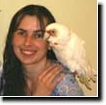My OLD Recipe
Kristen Reeves, Meadowlark Farms Avian Supply, Inc.
Before I began using a chitted seed mix as my high protein supplement during breeding & the molt, I used the egg food recipe below. My birds loved it, but with the advent of children activities and my increased activity, I no longer had the time to replace this egg based food every 2 hours. It's a great recipe for those who can dedicate the time to replace it regularly.
Offered throughout the day every day just prior to and during the entire breeding season. I check it often to make sure it hasn't spoiled.
- 2 hardboiled eggs, carefully washed and mashed WITH the shells left on
- ¼ apple, grated
- 1 cup shredded romaine lettuce
- 2 cups Higgins Protein or Morning Birds Miracle Meal (this could be any dried egg food supplement - choose one)
- 1 med. carrot, shredded
NOTE: Other greens and/or fruits & vegetables may be substituted. I use what I have on hand. But also note that many of the dry egg food products contain vitamins and minerals. If you choose to use one that is fortified with vitamins and minerals, be sure it is compatible with any other vitamin supplements you are offering. Rule of thumb – NEVER mix brands. Manufacturers create their supplements to work as a system. When you mix brands, you throw off the fine balance of that system!
Combine all of the above ingredients. If you're a lazy gardener like me, you can use a food processor - but don't overdo it - it will turn into a big ball of mush if processed too long! When I'm feeling too lazy to clean the big processor, I use my small processor designed to chop nuts or onions - small stuff - I'll use it for the carrot and egg. My birds go crazy when they hear either processor going. They know the "good stuff" is coming!
The mix should be crumbly – the consistency of crumb cake topping - and will smell somewhat like cake batter. If it is overly dry or wet, add a little water or dry egg food mentioned above until the desired consistency is obtained.
Store this mixture in a zipper bag or closed container in the refrigerator. The birds will eat approximately 2 tablespoons per day, sometimes more once they realize they like it – it should be offered every day just prior to and during the breeding season and until chicks fledge (leave the nest). You may adjust the amount of the egg food as you see them consume it. In warmer weather, it is best to remove the egg food after about two hours to avoid spoilage. This mixture will last approximately 1 week in the refrigerator or 6 months in the freezer.
REMINDER: A fat bird will not breed well, and other health issues can become a problem if the bird gets too fat. Egg food is fattening and should be limited when the birds are no longer breeding or molting.
TIP: Pack the mixture into ice cube traysand freeze. Once the mixture is completely frozen, dump it into a zipper bag for storage. Pull one cube out per pair of birds in a cage and offer right from the freezer. A regular sized ice cube = approximately 1 tablespoon.
I've also been known to add frozen peas or other vegetables I have on hand. When I'm feeling especially lazy or don't have time to chop, I use the fresh frozen cut mixed vegetables that come in a bag though I'm not sure the vitamin content is as good as that of fresh veggies.
Feel free to experiment with different combinations of fruits and vegetables. You may find your birds are particularly fond of some not mentioned here! NO avocado or onion please! AND, use Brassicaceaes (foods that belong to the cabbage family) such as cabbage, broccoli, cauliflower, turnip, rapeseed, mustard, radish, horseradish, cress, wasabi, and watercress sparingly – no more than once or twice per week. While very high in calcium and other nutrients, these foods can actually INHIBIT (prevent) calcium absorption. They are full of nutrients, but should be limited. I’ve seen bird keepers attach stalks of broccoli to the cage bars for the birds to eat at will only to find the hens become egg bound, and cocks begin sitting low on the perch because they weren’t able to store enough calcium in their long bones.





